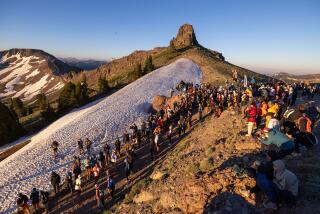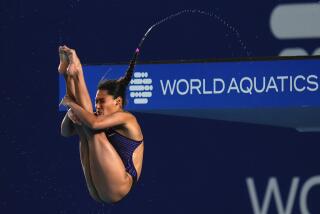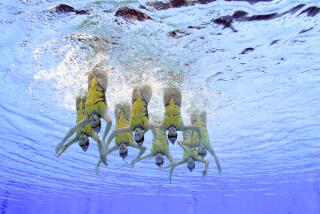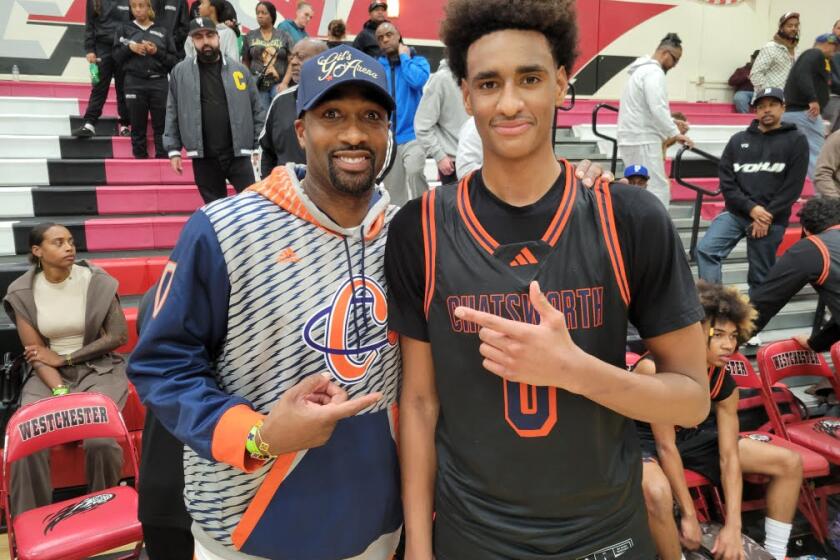Together, Twins Go the Distance--and Then Some : Endurance sports: At 49, Barbara Alvarez and Angelika Castaneda continue their quest to find their limits.
SAN DIEGO â Barbara Alvarez and Angelika Castaneda, 49, have plenty in common: They are identical twins, divorcees, mothers of two, native Austrians who married in Mexico and moved here, world-class triathletes and ultra runners.
They also share some blood-curdling horror stories.
Castaneda once watched her toenails fall off and half dollar-sized blisters pop on the bottoms of her feet early in a 146-mile run from Death Valley to Mt. Whitney in July, 1989.
It was 120 degrees, about 200 degrees on surface of the road.
âMy feet were all blisters and bleeding,â she said. âI had to cut my shoes so the toenails could stick out and I had to puncture holes in my nails to relieve the pressure (which worked temporarily).
âIt was one of the most painful experiences. I had to stop and cry many, many times, saying, âI cannot make it.â At times I literally crawled.
âBut with the endorphins going, you donât feel the pain so much as it looks.â
After the race, Castaneda spent the next month on crutches.
Alvarez, her younger sister by six hours, got sick from eating during a double triathlon in Alabama last year. She took a sedative and struggled to remain conscious while trying to complete a 224-mile bicycle ride. This, of course, after five miles of swimming and 52 miles of running.
âI came down from the bike, wanted to throw it away,â she said, âand I told my crew, âI give up.â â
She didnât.
Alvarez had another bike mishap in Germany earlier this month, taking a wrong turn that cost her an extra 16 miles on top of the regular 112. She still placed fourth.
Those misfortunes, however, couldnât compare with the hallucinations near Mt. Whitney and in the Western States 100-mile run in the Sierras in years past.
âI was seeing little men in the trees . . . people who had tents, but werenât really there,â she said, âhearing music that wasnât real, seeing aid stations that didnât exist . . .â
The mind was tricked, but her feet stayed on the ground and the body kept churning, from Squaw Valley to Auburn.
Alvarez and Castaneda ran their first marathon together in 1985, which led to ultra-marathons and triathlons and, eventually, to âadventure racingâ four years ago.
Now the twins, on the cusp of middle age, have risen to the top five in the world doing something most people would consider insane.
They cross-train daily, take 35-mile weekend runs on the beach from La Jolla to Oceanside and routinely defeat men 20 years their junior. They seems to specialize in experiencing extraordinary obstacles.
One thing they have never experienced is quitting.
Quitting means eliminating any chance of victory. And as children living in the Austrian village of St. Johann in Tirol (near the Swiss border), romping through the Alps, these two developed a lasting curiosity for what awaits on the other side of each mountain.
âSometimes youâre walking, just barely holding on, even holding on to a pacer--holding on forever,â Castaneda said. âI say to myself, âThe (tougher) it gets, the better it will get.â When itâs over, itâs wonderful.â
And when the competition is the Badwater 146 (miles) late July in Death Valley, or the Pacific Crest 50 on the John Muir Trail in a snowstorm, or in a spring sandstorm in the middle of the Sahara Desert in Morocco during the Marathon des Sables, a 135-mile stage race, it gets downright ghastly.
Thatâs right where Alvarez, a La Jolla psychologist, and Castaneda, an acrylic artist who dabbles in headhunting and private investigation, like to be. They feel a craving to test their limits as human beings and to search their souls.
âLife was an enigma,â said Alvarez, when asked why she chose to practice psychotherapy after successful careers as an actress, model and boutique owner in Mexico City. â âWhat is life?â I asked myself. âWhat are other people doing about life?â
âThe knowledge I have from sports, I bring it into my practice, because itâs how to live life.â
Yet she doesnât flaunt her eccentric lifestyle to her clients. She avoids telling them at all--but not out of fear they would think she needs therapy.
Larry Postenger, a five-year crewman for what they call the Twin Team, has a sibling-like relationship with the two and understands their passion.
âTheyâre living life to its capacity,â he said. âTheyâre pushing themselves to explore their capacity to be alive.â
âItâs hard to imagine unless youâve walked in those shoes,â added Postenger, an ultra-marathoner. âIâve walked in those shoes.â
But when it comes to events like the Badwater 146, shoes become useless. The twins overcame seemingly impossible odds of completing the race in 1989, when Castanedaâs ravaged feet swelled three sizes and Alvarez--hallucinating again--saw 14,495-foot Mt. Whitney bobbing and swaying while making her ascent on ski poles, her knee tendons severely inflamed.
They both finished in 53 hours, vowing to come back in 1990.
They did so, this time sporting boot-like ice wraps around their feet and legs. They crossed the finish line hand in hand (as the twins often do) after 38 hours 20 minutes, surpassing the womenâs record. They slept for 90 minutes of that time.
âYour mind becomes more creative in how to survive,â said Castaneda. âThe pain makes you creative.â
Despite the âlittle men in trees,â Alvarez and Castaneda finished first and second and set age-group records at the Western States 100 Mile in the Sierras. They did the same at the Pacific Crest Trail 50 Mile Ultramarathon, while weeping and avoiding frostbite at 6,000 feet.
Castaneda finished first, Alvarez second in the Hawaii Invitational Ultraman Triathlon: 6.2 miles in the water, 260 on bike, 52.4 on foot. They finished third and fourth (Castaneda the better by eight minutes) in the Hawaii World Championships Ironman Triathlon--an event they vow to win this October.
Castaneda is considered the stronger finisher of the two, Alvarez a sprinter who usually fares better in marathons and regular triathlons.
âI think I can just endure more pain,â Castaneda said. âBarbara is stronger, but what I lack in strength, I make up for with courage.â
âAll kinds of men . . . she leaves them behind,â Alvarez marveled.
Saddled with water bottles and 22-pound packs that contained sleeping bags and powdered food, the twins placed 20th and 21st (Castaneda beat Alvarez by 14 minutes) among 160 finishers in Marathon des Sables.
Alone on the Sahara dunes for seven days with nothing to guide them to the finish but a few markers and a compass, the twins were beaten by only one other woman. Forty competitors had to be rescued by helicopter or camel.
Adventure running offers a strange attraction.
Postenger said a man in his 30s decided to celebrate his birthday by taking a walk somewhere between Badwater (282 feet below sea level) and Furnace Creek, 18 miles west, the day before the twinsâ first Badwater race. The man never returned.
âHe set out across the salt flats,â said Postenger, a San Diego real estate agent. âA couple days later, his body was found.â
Postenger suggested that fulfillment in adventure racing comes from learning to expect natureâs hazards and respect her beauty.
âYes, itâs hot, yes, itâs overwhelming, but you feel friendly with the desert,â he said. âIt meets all your expectations. (Alvarez and Castaneda) were prepared for what they were going to encounter. The desert didnât let them down. Thatâs what you would expect from a friend.
âYou accept life and you embrace it. You have no alternative.â
The twins have not competed on the wilderness circuit this year, but not because they are mellowing. Not by any stretch of the imagination, said Castaneda.
âThere are so many challenges to conquer,â she said. âWe are looking for new ones.â
They had planned to enter a 600-mile stage race in the Australian outback this year, but it was canceled. It would have cost them $25,000 to enter. They compensated by conquering the France Triple Iron Triathlon, a 7.5-mile swim, 336-mile bike ride and 78-mile run in May. They were the only two women invited in a field of 32.
Castaneda finished eighth, beating the womenâs record of 51 hours 53 minutes by 5:23. Running alone at one point, she feared she was dead last. Shortly thereafter, a race official told her she was fourth.
âMy high at that moment was so great,â Castaneda said. âI ran the 78 miles without stopping. I never once walked.â
Alvarez, who was 13th, beat the record by three minutes.
Alvarez and Castaneda finished second and third in both the Catalina Island 50-mile ultra-marathon and the San Antonio Lake Wildflower triathlon this year. Earlier this month, Castaneda won her age group and Alvarez was fourth (despite getting lost) in an ultra-triathlon in Germany.
The twins donât miss a beat in their training (two to eight hours daily), hoping to peak for their October date in Hawaii. Also on the agenda are two triathlons in September and a half-triathlon in August, along with a marathon in December.
Their cross-training peaks on Saturdays and Mondays, when they ride 100 miles, run five and swim one, usually within eight hours. They still manage to squeeze in quality time for their children.
Alvarez has two daughters, Ingrid, 19, and Katrin, 12, and Castaneda has two sons, Alexis, 12, and Angelo, 11. And since Alvarezâs recent divorce, they all live in the same house in University City.
Perhaps the most difficult separation came 32 years ago, when the twins, the youngest of five, left their parents, Hans and Ingrid Muller, to explore the world.
Ingrid, in particular, remains their role model. She was a member of the Italian Olympic cross-country ski team. Now 79, Ingrid still hikes and skis, but she also attends to her girls during big races, cooking soup and often keeping all-night vigils.
âOur mother educated us with high expectations,â Castaneda said.
In 1960, their education moved to Florence, Italy, where they studied art history at the Accademia di Belle Arti and worked as fashion models to support themselves. They graduated four years later but decided to continue both in Mexico City, where they eventually met their husbands, both successful businessmen.
Alvarez borrowed from her sister to create a stage name--Barbara Angely--and became a popular actress. She starred in 25 Mexican motion pictures, usually playing the villain. Castaneda followed suit, swimming with sharks in a Jacques Cousteau documentary and doubling for Farrah Fawcett in the 1979 feature âSunburn.â
Capitalizing on their popularity, they opened four successful fashion boutiques and a charm school that enrolled 800 students a year. But they grew weary of public life, and, by the early 1970s, both had embarked on a course of self-realization, exploring every major religion.
In 1980, Alvarez was studying for a masterâs in psychology and moved to Brownsville, Tex., because of her husbandâs business. Castaneda moved to San Diego in 1985.
For five years, the twins were separated. But in many ways, the two women, in two states and separated by 2,000 miles, shared one mind.
On occasional visits, they discovered they had purchased the same set of china, the same blouse, and they picked out the same pair of shoes when each made separate visits to a boutique. They even made the decision to replace beef with turkey in their diets on the same date.
One thing they did not share symbiotically, at least at first, was Alvarezâs newfound passion, at 40, for running.
Alvarez got the bug in 1983. By mid-1986, the twins had completed a 43-mile across-and-back run of the Grand Canyon, a 112-mile bike race in Tucson (their first), two marathons and a 50-mile run in Los Angeles.
Strangely, Alvarez and Castaneda have never considered whether one could have competed on such a level without the other.
Said Alvarez, âNobody has made me that question before. The support I have in her, and she in me, is so enormous. We can pace each other . . .â
Said Castaneda, âIf I would have to train all by myself, I donât know if I could do it. I need someone to push; she needs to be pushed. Itâs a great team, a great partnership.â
Her work as a psychotherapist has led Alvarez to believe that each individual has potential beyond his or her awareness.
âI tell people to go out and test their potentials, which theyâre so afraid of,â she said. âThere is no victory without a battle. Touch the limits, stretch yourself. This is what gets you to a better quality of life.
âIâve learned that Iâm much greater than I thought, that God has given me a tenant which I have to use.â
And then she considered her greatest conquest in what has been nine years of intense mind- and body-stretching.
âIt had to be my first marathon,â she said, âbecause of not knowing what it was. It was just overwhelming.â
More to Read
Go beyond the scoreboard
Get the latest on L.A.'s teams in the daily Sports Report newsletter.
You may occasionally receive promotional content from the Los Angeles Times.










